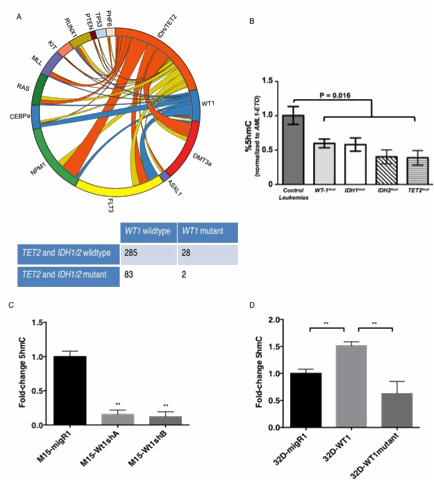Abstract
Mutations in TET2 and IDH1/2, which result in reduced conversion of 5-methylcytosine (5-mC) to 5-hydroxymethylcytosine (5-hmC), are observed in a significant proportion of patients with acute myeloid leukemia (AML). Hence these mutations define a novel class of AMLs with alterations in DNA methylation. However, it has been shown that not all AML cases with low levels of 5-hmC harbor somatic mutations in TET2 and IDH1/2. We hypothesized there are additional somatic mutations that can lead to alterations in TET enzyme function and resultant changes in the epigenetic state of hematopoietic cells.
Mutational studies of the ECOG 1900 trial allowed us to discover that somatic mutations in the WT1 gene were mutually exclusive of IDH1/2 mutations and negatively correlated with TET2 mutations (Figure 1A). 28/313 (9%) of TET2/IDH-wild-type patients had somatic WT1 mutations, whereas 2/85 (2%) TET2/IDH1/2-mutant patients had co-occurring WT1 mutations (p=0.026, Fisher's Exact test). Analysis of combined data from the ECOG 1900 study and the AML TCGA dataset confirmed a significant anti-correlation between WT1 mutations and TET2/IDH1/2 mutations (p=0.016). We next compared the DNA methylation profiles of WT1, TET2, and IDH1/2 mutant AML patients to AML patients wild-type for these disease alleles. Comparative analysis of the three hypermethylation profiles revealed a near-complete overlap of TET2 and WT1 hypermethylated loci within the IDH1/2 hypermethylation signature, and a highly significant overlap between the TET2 and WT1 mutant signatures (p-value< 0.001 for all comparisons), consistent with convergent, site-specific effects on DNA methylation.
These genetic observations suggested a shared functional role for WT1, TET2, and IDH1/2 mutations in AML in regulating 5-hmC. WT1-mutant AML patients had significantly reduced 5-hmC (Liquid chromatography-electron spray ionization-tandem mass spectrometry) compared to AML patients wild-type for WT1, TET2 or IDH1/2 (p=0.016 T-test Figure 1B), similar to the reduction in 5-hmC observed in IDH1/2-mutant and TET2-mutant AML patient samples. In order to determine the impact of IDH1/2, WT1 and TET2 mutations on the distribution of epigenetic marks throughout the genome more precisely, we examined 5-hmC localization in primary AML specimens with next-generation sequencing. The average number of 5-hmC peaks present in samples from AML patients with TET2, WT1, IDH1 or IDH2 mutations was significantly reduced compared to AML patients wild-type for these disease alleles (t-test p-values between 0.0005 and 0.003). We observed highly significant overlap of differential 5-hmC peaks lost in WT1-mutant AML and TET2-mutant AML (Hypergeometric test p-value < 10-133). In a manner analogous to the findings for DNA methylation, the regions with reduced 5-hmC in WT1/TET2 mutant AML were a subset of those found in IDH1/2 mutant AML patients.
We next investigated whether perturbations in WT1 expression can directly alter 5-hmC levels. Knockdown of Wt1 significantly decreased 5-hmC levels in M15 cells (p<0.01) (Figure 1C). Conversely, overexpression of WT1 in 32D cells significantly increased 5-hmC levels compared to cells expressing a control vector or WT1-mutant (p<0.05) (Figure 1D). Thus, WT1 can directly regulate 5-hmC levels. Given the effects of WT1 on 5-hmC levels and the inverse correlation between WT1 and TET2 mutations in AML, we hypothesized that WT1 might modulate TET2 function through direct interaction.Co-immunoprecipitation experiments demonstrated WT1 interacts with TET2 and with TET3. Consistent with these effects, WT1 expression inhibited colony forming ability of TET2-deficient cells, but could not attenuate the colony growth of TET2/TET3-deficient cells in vitro.
Taken together, our genetic and functional studies demonstrate an inverse correlation between WT1 mutations and TET2/IDH1/2 mutations in AML and a functional role for WT1 in regulating DNA methylation. WT1 mutant AML is characterized by similar global and site-specific alterations in 5-hmC/5-mC as observed in TET2/IDH1/2 mutant AML. Furthermore, we demonstrate that alterations in WT1 levels directly regulate 5-hmC levels, which is due to an interaction between TET2/TET3 and WT1. These data provide a novel role for WT1 in regulating DNA hydroxymethylation and suggest that TET2 IDH1/2, and WT1 mutations define a novel AML subtype.
Levine:Novartis: Consultancy, Grant support Other.
Author notes
Asterisk with author names denotes non-ASH members.


